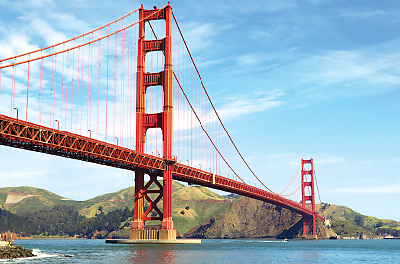Though Inspiring Awe in Millions, Famed Bridge Has a Dark Side
Abstract
The Golden Gate Bridge leads a double life as an iconic architectural marvel, but also as a suicide magnet; however, a remedy for the latter is still not imminent.
More than 10 million people will visit the iconic Golden Gate Bridge this year. If you’ve never been there—or even if you have—now is a great time to go. In 2012, the bridge, which connects San Francisco to the northern suburbs of Marin County with its stunning span that includes 746-foot towers, sweeping cables, Art Deco style, and iconic color, celebrated its 75th anniversary.

The Golden Gate Bridge is the second-longest suspension bridge in the United States, after the Verrazano-Narrows Bridge in New York City.
Many of the renovations and programs associated with the celebration continue to enhance the tourist experience for bridge visitors. For example, the celebration included renovation of the Golden Gate Bridge Visitor Plaza, located on the San Francisco side of the bridge. A new Bridge Pavilion there provides orientation and information services, houses exhibits, and offers commemorative and gift merchandise. The pavilion’s remodeled cafe offers an all-new menu. The historic Round House has become the location for a “green screen” photography experience where visitors can create photos of themselves scaling the bridge or perching atop the South Tower; it’s also the launching point for new guided audio tours of the bridge.
Of course, one can’t visit the Golden Gate Bridge without also considering its darker side. It is the site of more deaths by suicide than any other location in the world. Since it opened on May 27, 1937, there have been an estimated 1,600 deaths in which the body was recovered, and many more that were suspected but unconfirmed. In 2011, there were 37 unconfirmed suicides, the fourth-highest total in the bridge’s history.
“The Golden Gate Bridge is the only major international landmark without a suicide barrier,” wrote John Bateson, author of The Final Leap: Suicide on the Golden Gate Bridge (2012, University of California Press) and the former executive director of a San Francisco Bay Area crisis center, in the May 25, 2012, Los Angeles Times. “From the Eiffel Tower to the Empire State Building, St. Peter’s Basilica to the Sydney Harbour Bridge, every other one-time suicide magnet has had a barrier erected. The Golden Gate Bridge has not. Its short, four-foot-high railing can be surmounted by almost anyone,” he wrote.
The last time APA visited San Francisco for its annual meeting, in 2009, the future for efforts to end suicides from the bridge held promise. In October 2008, the Golden Gate Bridge, Highway, and Transportation District took the historic step of approving the first permanent suicide deterrent, a structure of suspended steel nets to be placed about 20 feet below the bridge’s sidewalks. The approval followed a five-year public-awareness and lobbying effort by the Psychiatric Foundation of Northern California’s Golden Gate Bridge Suicide Barrier Task Force, other mental health advocates, and families of people who completed suicide by leaping from the bridge.
In July 2011, a contract for design of the nets was awarded with a target date of 2013 to complete the design. But advocates say the pace of the effort is too slow, and funding—estimated to be around $50 million—has yet to be identified.
On Tuesday, May 21, APA annual meeting attendees can revisit efforts to address suicide from the Golden Gate Bridge in a session that will be chaired by Mel Blaustein, M.D., president of the Psychiatric Foundation of Northern California. The panel of speakers will include two family members whose adolescent children died by suicide, two psychiatrists who are experts in suicide, the director of San Francisco Suicide Prevention, the former Marin County coroner, and the CEO and former chief engineer of the Golden Gate Bridge. ■
Information on visiting the Golden Gate Bridge is posted at http://www.goldengatebridge.org. The Golden Gate Bridge, Highway, and Transportation District’s timeline for construction of a suicide barrier is posted at http://www.ggbsuicidebarrier.org/.



